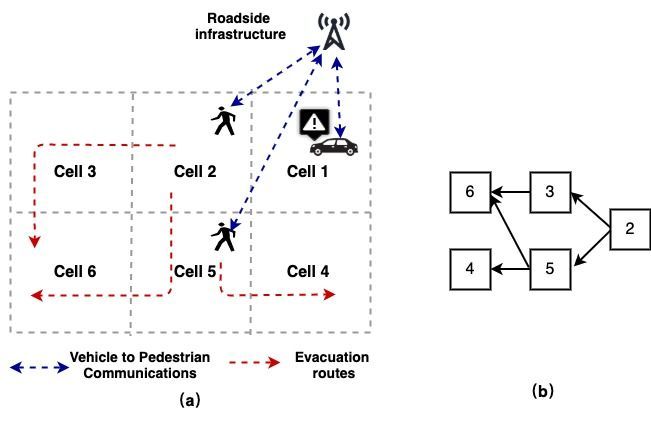A conference paper submitted to VTC2021-Spring by TransSec researchers got accepted recently, marking a step forward towards the overall success of TransSec’s work on research and development.
The Vehicular Technology Conference (VTC) is the semi-annual flagship conference of the IEEE Vehicular Technology Society and focuses on wireless, mobile, and vehicular technology. IEEE VTC2021-Spring will be held 25-28 April 2021 in Helsinki, Finland and will feature world-class plenary speakers, tutorials, technical as well as application sessions, and an innovative Industry Track.
The conference paper is titled “A Pedestrian Evacuation Model for ITS based on Cell Transmission Model and Linear Programming”, with Ruisong Han, Martin Tolan, Frances Cleary and Fan Zhang from TSSG, Waterford Institute of Technology as authors. With the development work in the WP6 Vehicle-to-Everything (V2X) Communications, TSSG researchers found that the V2P (Vehicle-to-Pedestrian) application developed within WP6 can achieve better functionalities, with innovative evacuation models designed and implemented.
Earlier, a survey on the disaster evacuation solutions by the team found that current solutions neither fully utilize the modern communications techniques such as Vehicle-to-Everything (V2X) Communications nor have a practical and optimized model for evacuating vehicles and pedestrians. Thus, the team has proposed an improved route-based linear programming (IRLP) optimization model for evacuation, which is specially tailored for the emergency evacuation problem of pedestrians in ITS. Specifically, the proposed model utilizes the Cell Transmission Model (CTM) and linear programming to model the pedestrian evacuation. Figure 1 illustrates the cell representation of a road network where a security event in Cell 1 will be communicated to the pedestrians in other virtual cells through V2P. Then, we can further use the proposed linear programming equations to calculate an optimized evacuation plan with the cell representation.

The research results highlight that the proposed model can optimize the pedestrian flow to alleviate potential congestion (caused by adopting similar evacuation routes) when the density of pedestrian is high. This is a great supplement to the current research since existing work may either use microscopic or macroscopic models, without taking the benefits of the two to improve overall evacuation efficiency. Besides, with more vehicle-based attacks in recent years, V2X solutions with evacuation algorithms and applications accompanied can better ensure road security.
Below is the abstract of the paper:
System-Optimal Dynamic Traffic Assignment (SODTA) problem optimizes the time-dependent traffic flow of a transportation network, with varied objectives and complicated constraints. Traffic management applications of Intelligent Transports Systems (ITS), such as emergency evacuation, network optimization, and route planning, rely on SO-DTA models to obtain sophisticated solutions to optimize network performance. In this paper, an improved route-based linear programming (IRLP) optimization model is proposed, specially tailored for the emergency evacuation problem of pedestrians in ITS. The proposed model utilizes the Cell Transmission Model (CTM) and linear programming to model the pedestrian evacuation and introduces penalty labels in the IRLP formulations to solve the holding-back flow issue. Besides, when designing the model, the categories of transmission cells are simplified to make the model more practical, compared to some previous research work. Finally, a series of simulation experiments, including the comparison to the real-world shortest-path evacuation strategies, are conducted to showcase the effectiveness in saving valuable evacuation time.

